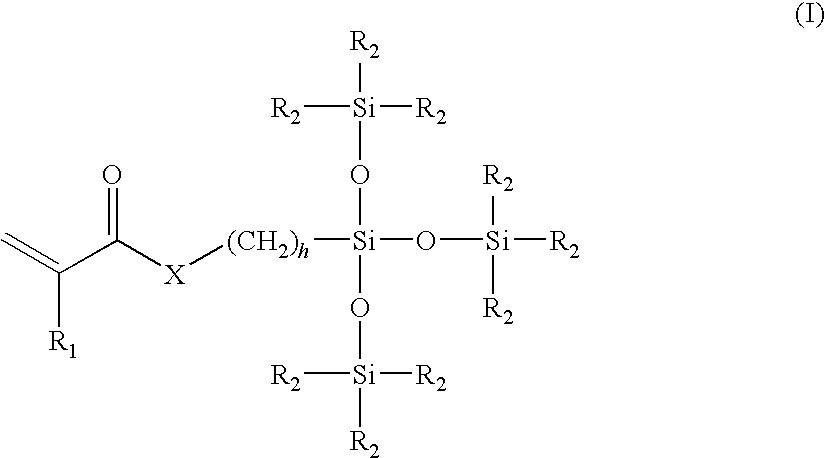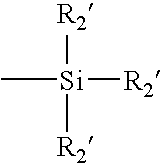Process for Making Biomedical Devices
a biomedical device and process technology, applied in the field of ophthalmic devices, can solve the problems of difficult mixing pvp, affecting optical clarity or irritating the eye, and the lens-forming monomer may not be fully polymerized,
- Summary
- Abstract
- Description
- Claims
- Application Information
AI Technical Summary
Problems solved by technology
Method used
Image
Examples
example 1
Lens Casting
[0084]A master batch of monomer mixture is prepared from the components listed in Table 1. The amounts in Table 1 are parts by weight percent (pbw) unless otherwise noted.
TABLE 1ComponentParts by WeightID2S4H11TRIS35DMA11NVP40HemaVC0.5Hema53-methoxy-1-butanol3IMVT150 ppmUV-agent0.5
[0085]To a portion of this master batch was added 0.5 wt % Vazo-64 initiator (control). To 107 parts of this master batch were added the following additional components: Mixture 1-1 part by weight MAA and 0.5 wt % Vazo-64 initiator; Mixture 2-1.5 parts by weight MAA and 0.5 wt % Vazo-64 initiator; Mixture 3-2 parts by weight MAA and 0.5 wt % Vazo-64 initiator.
[0086]Dosages of these monomer mixtures were placed between anterior and posterior contact lens molds, and thermally cured at 70° C. Following curing, the posterior mold sections were removed, and the contact lenses were released from the anterior mold sections.
example 2
Lens Treatment
[0087]The lenses cast in Example 1 were soaked for two cycles in a solution of 3-methoxy-1-butanol including 1 weight percent PVP (Mn 360,000) at 60° C., for 3 minutes each cycle. During this time, the lenses were swollen more than 40% in dimensions. The lenses where then placed in deionized water, and the lenses quickly shrunk. They were then placed in borate buffered saline and autoclaved. As a control, lenses were also extracted in the same solvent but without the PVP, and then placed in water and autoclaved in borate buffered saline. All lenses were inspected manually by rubbing the lenses between fingers.
[0088]All lenses extracted with 3-methoxy-1-butnaol containing PVP showed better lubricity than the control lenses extracted without the presence of PVP. Also, Lenses from Mixture 3 (2 pbw MAA) showed the highest lubricity. Lenses from Mixtures 2 (1.5 pbw MAA) and Mixture 1 (1 pbw MAA) had better lubricity than lenses from the Control Mixture (0 pbw MAA).
example 3
Lens Treatment
[0089]Example 2 was repeated except PVP (Mn 50,000) in isopropanol was used for the lens treatment. After full processing, the lenses were much more lubricious than the control lenses extracted with isopropanol alone.
PUM
| Property | Measurement | Unit |
|---|---|---|
| hydrophilic | aaaaa | aaaaa |
| volume | aaaaa | aaaaa |
| organic | aaaaa | aaaaa |
Abstract
Description
Claims
Application Information
 Login to View More
Login to View More - R&D
- Intellectual Property
- Life Sciences
- Materials
- Tech Scout
- Unparalleled Data Quality
- Higher Quality Content
- 60% Fewer Hallucinations
Browse by: Latest US Patents, China's latest patents, Technical Efficacy Thesaurus, Application Domain, Technology Topic, Popular Technical Reports.
© 2025 PatSnap. All rights reserved.Legal|Privacy policy|Modern Slavery Act Transparency Statement|Sitemap|About US| Contact US: help@patsnap.com



